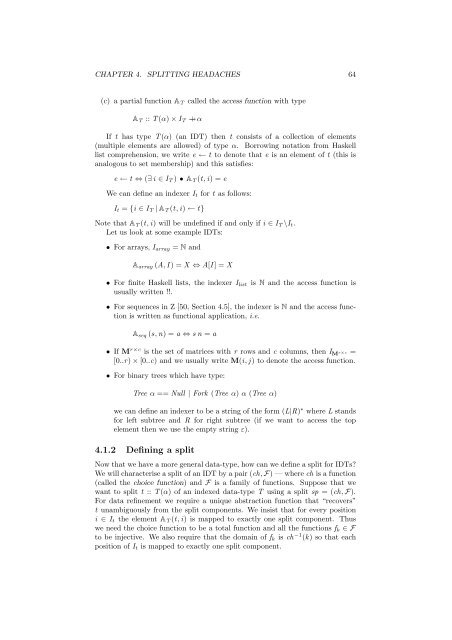Obfuscation of Abstract Data-Types - Rowan
Obfuscation of Abstract Data-Types - Rowan
Obfuscation of Abstract Data-Types - Rowan
You also want an ePaper? Increase the reach of your titles
YUMPU automatically turns print PDFs into web optimized ePapers that Google loves.
CHAPTER 4. SPLITTING HEADACHES 64<br />
(c) a partial function A T called the access function with type<br />
A T :: T(α) × I T →+ α<br />
If t has type T(α) (an IDT) then t consists <strong>of</strong> a collection <strong>of</strong> elements<br />
(multiple elements are allowed) <strong>of</strong> type α. Borrowing notation from Haskell<br />
list comprehension, we write e ← t to denote that e is an element <strong>of</strong> t (this is<br />
analogous to set membership) and this satisfies:<br />
e ← t ⇔ (∃i ∈ I T ) • A T (t,i) = e<br />
We can define an indexer I t for t as follows:<br />
I t = {i ∈ I T | A T (t,i) ← t}<br />
Note that A T (t,i) will be undefined if and only if i ∈ I T \I t .<br />
Let us look at some example IDTs:<br />
• For arrays, I array = N and<br />
A array (A,I) = X ⇔ A[I] = X<br />
• For finite Haskell lists, the indexer I list is N and the access function is<br />
usually written !!.<br />
• For sequences in Z [50, Section 4.5], the indexer is N and the access function<br />
is written as functional application, i.e.<br />
A seq (s,n) = a ⇔ s n = a<br />
• If M r×c is the set <strong>of</strong> matrices with r rows and c columns, then I M r×c =<br />
[0..r) × [0..c) and we usually write M(i,j) to denote the access function.<br />
• For binary trees which have type:<br />
Tree α == Null | Fork (Tree α) α (Tree α)<br />
we can define an indexer to be a string <strong>of</strong> the form (L|R) ∗ where L stands<br />
for left subtree and R for right subtree (if we want to access the top<br />
element then we use the empty string ε).<br />
4.1.2 Defining a split<br />
Now that we have a more general data-type, how can we define a split for IDTs?<br />
We will characterise a split <strong>of</strong> an IDT by a pair (ch, F) — where ch is a function<br />
(called the choice function) and F is a family <strong>of</strong> functions. Suppose that we<br />
want to split t :: T(α) <strong>of</strong> an indexed data-type T using a split sp = (ch, F).<br />
For data refinement we require a unique abstraction function that “recovers”<br />
t unambiguously from the split components. We insist that for every position<br />
i ∈ I t the element A T (t,i) is mapped to exactly one split component. Thus<br />
we need the choice function to be a total function and all the functions f k ∈ F<br />
to be injective. We also require that the domain <strong>of</strong> f k is ch −1 (k) so that each<br />
position <strong>of</strong> I t is mapped to exactly one split component.
















